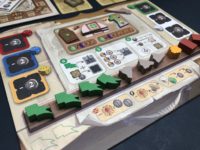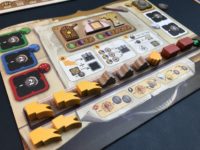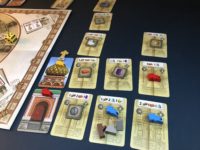- Learning time
- 40 minutes
- First play time
- 120 minutes
The Red Cathedral
Designed by: Israel Cendrero,Sheila Santos
In sixteenth century Russia, Ivan the Terrible commissioned the building of St Basil’s cathedral, Moscow. It took a decade. Four and a half centuries later, this stunning building is still standing – but will you be after you attempt to recreate it’s construction?
There’s three main things to consider as you open the box. Each player has a player board that tracks both how many resources they have and how they have upgraded their actions – more on that momentarily. There’s the cathedral itself – formed of cards laid out representing various sections of the building – and there’s the market board, which is really the heart of how the game functions.
On your turn you’ll choose one of three actions: claiming a section of the cathedral to build; moving resources from your board to one of your sections under construction, or gathering resources at the market. The first two actions are very simple: to claim a section of the cathedral as one you intend to build, you simply put a banner on any section that hasn’t yet been claimed, as long as any sections beneath it are either built or already under construction. You take the workshop tile there too – these will improve your actions at the market, as we’ll see.
Moving resources is just how it sounds: you can move up to three resources to any sections of the cathedral you’re currently working on. If doing so means that that section of the cathedral is now complete, you take the rewards (money/points) and flip the card over, keeping your banner there to show you built it.
The market board functions as a kind of wheel that dice move around. When you gather resources, you simply move a chosen die the number of spaces it shows on its face-up side, and then gather wood, stone, gold, or whatever, from the section the die stops in: the number of resources you gather is the token there (eg 1 gold or 2 bricks) multiplied by the number of dice in that section. Time it right, and you can pick up a lot of stuff like this. If you’ve added workshop tiles to a particular die, moving that will trigger whatever bonus the workshop offers: it might be an additional resource, a bit of cash, or the reward for wherever another coloured-die happens to be in that moment. Finally – if the market wasn’t already alluring enough – you also get to do a special action; there being one in each quadrant of the market. These vary from game to game but are all relatively simple assistance: turn 2 of one resource into 1 of another type of thing. Once you’ve done these three actions – in any order – you roll all the dice in the section you used to end your turn. The resource conversion is in fact very handy – both because the amount of resources you can store on your board is finite, and because each section of the cathedral can demand up to three different kinds of resource.
And it’s the disconnect between the gathering of resources and spending them that you manage in the Red Cathedral, because if, say, you need stone wood and gems for a particular section, you can bet your bottom dollar the dice will arrange themselves in such a way that the best moves are going for gold, bricks and cash instead…
Cash is useful in The Red Cathedral not because it contributes to the cathedral itself – it doesn’t – but because it allows you to manipulate dice movement. Every player can move any die they like, but one specific colour is ‘your’ colour, which means you can pay a coins to move it one or more sections further (or less far) than it might otherwise move. What might sound like a handy option can at times prove critical!
The final thing to consider here is the end-game and scoring. As soon as any one player builds their final section of cathedral (ie all their banners are used up) everyone else gets one final turn, and then each ‘column’ of the building rewards points based on who contributed the most. This majority-scoring gives The Red Cathedral a slight tension and edge as the game hits the final straight, with everyone seeking to maximise their contributions as time runs out…
The guru's verdict
-
Take That!
Take That!
The game's predominant focus is building, but there are some combative elements: in the sense you're racing to complete your banners, struggling for majorities in construction and - lest we forget - there are point deductions for not completing a section of building when a section above it is completed!
-
Fidget Factor!
Fidget Factor!
Drops from high in the first play to moderate. Claiming and building turns are, to be fair, super-fast. The market action is what can sometimes cause the game to go into lulls, as someone looks at what they need and the best way - assuming there is one - to go about getting it.
-
Brain Burn!
Brain Burn!
At heart it's just get resources, and use them to build. That market though is where the thinkiness comes in, and gives you pause for thought...
-
Again Again!
Again Again!
...and those pauses - and the market itself - will probably define how much you desire to return. It's very puzzly, and the die-rolls and special action cards bring elements of unpredictability. The cathedral itself also has a randomised element to set-up.










Sam says
Ten years ago I would have adored The Red Cathedral - which is not to damn it with faint praise at all: I really enjoyed it and I like a game like this where decisions feel more round-by-round tactical rather than over-archingly strategic. My tastes these days usually tend more towards narrative, interactive-type games where I feel like we're telling a story together. Or games where there's high level interaction and a feisty, combative air. But those are just my tastes, and I actually feel The Red Cathedral does what it does very well. There's a more puzzley vibe that suits a leisurely game pace for leisurely gamers. But it's not so gentle that any notion of competition evaporates - it can, in fact, get a little dramatic towards the end when you really need stone, for instance, and find the player before you inevitably moves the die you wanted to move and harpoons your plans! The down-side of that plan-harpooning is that you can't always plan ahead, and time is necessary on market turns to figure out your best move. With four players, that will push the game long (the cathedral is larger with more players too) and how you feel about your experience will probably come down to how much joy you find in the action-selection mechanic of the market.